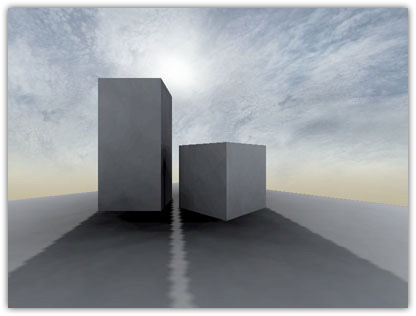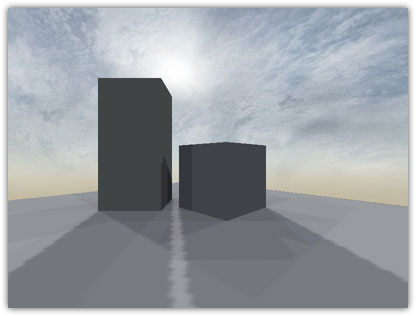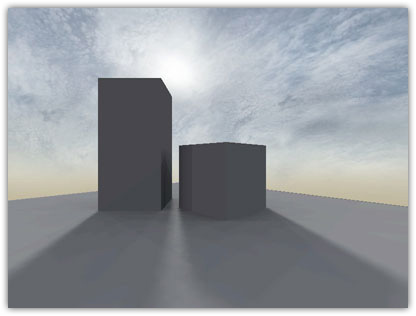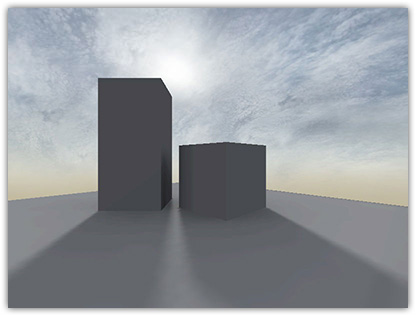Q3Map2 surface light and sky shaders are quite different than the original Quake III shaders. As new lighting algorithms were introduced, new shader keywords were created to accompany or replace the original keywords. This section will illustrate the differences between these shaders.
(Pending)
Originally, sky shaders were just very large surface lights that casted parallel directional lighting. With Q3Map2, there are a few differences that sets sky shaders apart from surface lights. First of all, we'll take a look at how the pre-Q3Map2 shaders were set up:
textures/shadermanual/sky
{
skyparms textures/shaderlab_terrain/env/sky 1024 - //farbox cloudheight nearbox
q3map_lightImage textures/shaderlab_terrain/sky_clouds.tga
q3map_sun 1 1 1 140 -35 25 //red green blue intensity degrees elevation
q3map_lightSubdivide 256 //sets a pointlight every 256 game units
q3map_surfaceLight 200 //emits 200 units of light
surfaceparm sky //flags compiler that this is sky
surfaceparm noimpact
surfaceparm nolightmap
surfaceparm nodlight
nopicmip
nomipmaps
qer_editorimage textures/shaderlab_terrain/sky_clouds.tga
{
map textures/shaderlab_terrain/sky_clouds.tga
tcMod scale 3 3
//tcMod scroll 0.005 -0.0125
rgbGen identityLighting
}
{
map textures/shaderlab_terrain/sky_arc_masked.tga
blendFunc GL_ONE_MINUS_SRC_ALPHA GL_SRC_ALPHA
tcMod transform 0.25 0 0 0.25 0.1075 0.1075
rgbGen identityLighting
}
}
Keep in mind that this is a generalized shader, and that there can be a lot of different variations to yield different effects. Take a look at some of the original Quake III Arena shaders for more examples. In this screenshot (compiled with LIGHT -fast, viewed with /r_lightmap 1), the effect isn't bad, but the shadows are a bit jagged.

Q3Map2 sky shaders improves on the way lightmaps are calculated, improving both quality and compiler performance. This is essentially the same shader with some small changes:
textures/shadermanual/sky
{
skyparms textures/shaderlab_terrain/env/sky 1024 -
q3map_lightImage textures/shaderlab_terrain/sky_clouds.tga
q3map_sun 1 1 1 140 -35 25
q3map_skylight 100 3 //amount iterations
surfaceparm sky
surfaceparm noimpact
surfaceparm nolightmap
surfaceparm nodlight
nopicmip
nomipmaps
qer_editorimage textures/shaderlab_terrain/sky_clouds.tga
{
map textures/shaderlab_terrain/sky_clouds.tga
tcMod scale 3 3
//tcMod scroll 0.005 -0.0125
rgbGen identityLighting
}
{
map textures/shaderlab_terrain/sky_arc_masked.tga
blendFunc GL_ONE_MINUS_SRC_ALPHA GL_SRC_ALPHA
tcMod transform 0.25 0 0 0.25 0.1075 0.1075
rgbGen identityLighting
}
}
What we've done here is replace q3map_lightSubdivide and q3map_surfacelight with q3map_skylight which yields more uniform shadows at a fraction of the compile time. However, this also generates the "stadium light" effect - producing some unwanted shadows. We'll fix this later.

To solve the problem with jagged shadow edges, we can smooth out the shadows by blurring the lightmap. Depending on the type of lighting that you want to achieve for the sun (a cloudy day, for example), you can create a penumbra (half-shadow) effect using q3map_sunExt. This simulates the way sunlight bounces in certain conditions, creating a slight "jittering" effect. This is the same shader again with q3map_sunExt.
textures/shadermanual/sky
{
skyparms textures/shaderlab_terrain/env/sky 1024 -
q3map_lightImage textures/shaderlab_terrain/sky_clouds.tga
q3map_sunExt 1 1 1 140 -35 25 3 16 //adds deviance and samples
q3map_skylight 100 3
surfaceparm sky
surfaceparm noimpact
surfaceparm nolightmap
surfaceparm nodlight
nopicmip
nomipmaps
qer_editorimage textures/shaderlab_terrain/sky_clouds.tga
{
map textures/shaderlab_terrain/sky_clouds.tga
tcMod scale 3 3
//tcMod scroll 0.005 -0.0125
rgbGen identityLighting
}
{
map textures/shaderlab_terrain/sky_arc_masked.tga
blendFunc GL_ONE_MINUS_SRC_ALPHA GL_SRC_ALPHA
tcMod transform 0.25 0 0 0.25 0.1075 0.1075
rgbGen identityLighting
}
}
In the following screenshot, you can see that the jagged shadow edges are gone.

As mentioned above, you may be faced with problems involving the "stadium lights" effect when using q3map_skyLight. We can eliminate this problem by using higher values for the q3map_sunExt samples and q3map_skyLight iterations parameter, but at the cost of a higher compile time. For example, q3map_sunExt 1 1 1 140 -35 25 3 32 and q3map_skylight 100 6.
Note:
Since the time that these screenshots were taken, the skylight subdivision code has been greatly improved (Q3Map2 2.5.14) for far more uniform lighting and faster compiles, so using higher iteration values can result in better quality, reducing the "stadium light" effect and without necessarily increasing compile times.

A faster approximate alternative of getting rid of the "stadium lights" effect is to use q3map_lightmapFilterRadius.
textures/shadermanual/sky
{
skyparms textures/shaderlab_terrain/env/sky 1024 -
q3map_lightImage textures/shaderlab_terrain/sky_clouds.tga
q3map_sunExt 1 1 1 140 -35 25 3 16
q3map_lightmapFilterRadius 0 8 //self other
q3map_skyLight 100 3
surfaceparm sky
surfaceparm noimpact
surfaceparm nolightmap
surfaceparm nodlight
nopicmip
nomipmaps
qer_editorimage textures/shaderlab_terrain/sky_clouds.tga
{
map textures/shaderlab_terrain/sky_clouds.tga
tcMod scale 3 3
//tcMod scroll 0.005 -0.0125
rgbGen identityLighting
}
{
map textures/shaderlab_terrain/sky_arc_masked.tga
blendFunc GL_ONE_MINUS_SRC_ALPHA GL_SRC_ALPHA
tcMod transform 0.25 0 0 0.25 0.1075 0.1075
rgbGen identityLighting
}
}
The self and other parameters are the amount of filtering applied on the lightmap in world units. The self value is always set to "0" on sky shaders since skies don't have lightmaps. The q3map_lightmapFilterRadius directive should always be placed before any light-related directives that you want it to affect. In our case, we placed it after q3map_sunExt and before q3map_skyLight so that it filters the stadium lights, but won't blur the sun shadows which are already jittered. This produces very similar results without the long compile times.

Reference: Obsidian (2004). Shader Lighting Experiment, Quake3World (link currently down, see here).
(Pending)